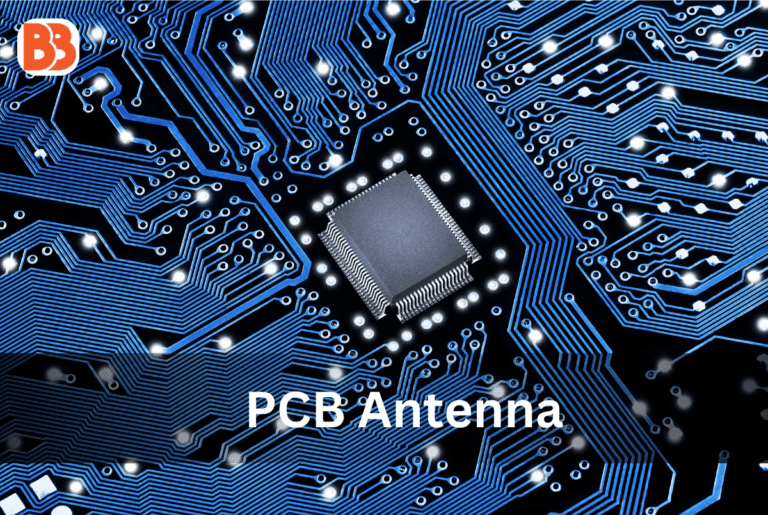The PCB Antenna is integrated into the printed circuit board (PCB) substrate, using the conductive traces and components as their conductors. They are popular for their compact size, low cost, easy integration, and design flexibility. PCB antennas can be used in various wireless applications, such as communication systems, IoT devices, medical equipment, wearable gadgets, and the automotive industry.
What are the types of PCB Antenna?
There are several PCB Antenna, each with advantages and disadvantages. The best choice depends on the application requirements, available space, and desired performance.
1. Microstrip patch antenna
Microstrip patch antenna is a planar antenna consisting of a radiating patch on the top and a ground plane at the bottom of the PCB.


It can use contacting or coupling feeding techniques. It has a low profile, high bandwidth, and moderate gain. However, it also has a narrow beam width, high cross-polarization, and surface wave losses.
2. Monopole antenna
It is a wire antenna that extends from the PCB and is fed by a coaxial cable. It has a simple structure, omnidirectional radiation pattern, and moderate gain.
However, it also requires a large ground plane, has a limited bandwidth, and is prone to interference.
3. Dipole antenna
It is a balanced antenna consisting of two identical conductive elements on the PCB fed by a balanced line. It has a bidirectional radiation pattern, wide bandwidth, and low cross-polarization.
However, it also requires a large PCB area, low gain, and sensitivity to the surrounding environment.
4. Loop antenna
A closed-circuit antenna forms a loop on the PCB, fed by a balanced or unbalanced line. It is small, highly efficient, and radiation-resistant. However, it also has a low bandwidth, low gain, and high reactance.


Choosing the right PCB antenna type depends on the specific application requirements, such as frequency range, gain, radiation pattern, polarization, and physical size constraints. Designing a PCB antenna involves analyzing its planned use, picking the suitable type, designing its physical structure, optimizing impedance matching, fine-tuning the radiation design, simulating the antenna, and operating useful tests.
How to use a PCB Antenna?
To use a PCB antenna, you must design the antenna circuit and layout, following some basic steps and best practices. Here is a general overview of the process: 

1. Type and placement of the antenna
Choose the type and placement of the antenna on the board based on the device’s frequency range, radiation pattern, size, and shape. For guidance, refer to some reference designs and product specifications.
2. Design the antenna circuit
Design the antenna circuit using the appropriate components and values for the radio and the antenna.
You may need to add a matching network to ensure the antenna’s impedance is close to 50 ohms, which is the standard for most wireless systems.
3. Design the PCB layout
Design the PCB layout using a transmission line to connect the antenna and the radio. Depending on the board stack-up and the substrate’s dielectric constant, the transmission line can be a microstrip, a stripline, or a coplanar waveguide.
You can use an online calculator to determine the dimensions of the transmission line for a given impedance.
4. Large ground plane
Make sure the ground plane is large enough and aligned with the antenna. The ground plane affects the performance and efficiency of the antenna, and it should be as close as possible to the antenna. Avoid placing any components or traces near the antenna, as they may cause interference or detuning.
5. Measure the output power
Measure the radio’s output power, frequency, and harmonics using a spectrum analyzer and a coaxial cable. Using a network analyzer and a coaxial cable, you can also measure the antenna’s input impedance and resonant frequency.
Adjust the components’ values and the antenna’s length to optimize performance and efficiency.
6. Repeat the measurements
Repeat the measurements until you achieve the desired results. You can also test the antenna in different environments and orientations to evaluate its radiation pattern and coverage.
7. Sensitive to the surrounding environment
PCB antennas are sensitive to the surrounding environment, such as nearby objects, metal surfaces, and human bodies. These factors can affect the antenna’s performance, efficiency, and radiation pattern. Therefore, testing the antenna in realistic scenarios and accounting for possible interference and detuning effects is important. Do you want to know All About Chiplet Technology Advanced PCB Design
8. Careful tuning
PCB antennas require careful tuning and matching to achieve optimal performance and minimize losses. Tuning refers to adjusting the antenna’s resonant frequency to match the desired operating frequency. Matching refers to ensuring the antenna’s input impedance is close to the characteristic impedance of the transmission line and the radio.
Tuning and matching can be done by changing the antenna’s length, shape, or position or adding passive components such as capacitors and inductors.
9. Various software tools
PCB antennas can be designed using various software tools, such as electromagnetic (EM) simulators, circuit simulators, and layout editors. EM simulators can help analyze the antenna’s radiation characteristics, such as gain, efficiency, and directivity. Circuit simulators can help design the antenna’s circuit, such as the matching network and the transmission line. Layout editors can help create the antenna’s physical layout on the PCB, following the design rules and constraints.
10. Fabricated by using different methods
PCB antennas can be fabricated using different methods, such as etching, milling, or printing. Etching is the most common method involving removing unwanted copper from the PCB using a chemical solution. Milling is a mechanical method of cutting the antenna shape using a rotating tool.
Printing is a newer method that uses a printer to deposit conductive ink or paste it on the PCB. Each method has advantages and disadvantages, such as cost, accuracy, and speed.
Frequently asked questions
Here are some frequently asked questions about how to use PCB Antenna:
1. What is a PCB antenna?
A: A PCB antenna is an antenna that is integrated into the printed circuit board of a wireless device, using the PCB as a substrate.
2. What are the advantages of PCB Antenna?
A: PCB antennas offer advantages such as compact size, low cost, easy integration, and design flexibility.
3. What are the types of PCB Antenna?
A: There are many PCB antennas, such as monopole, dipole, inverted-F, patch, and loop antennas. Each type has its characteristics and applications.
4. How to design a PCB Antenna?
A: To design a PCB antenna, you need to choose the type and placement of the antenna, design the antenna circuit and layout, and measure and tune the antenna performance.
5. What are the challenges of PCB Antenna design?
A: Some challenges of PCB antenna design are environmental interference, impedance matching, bandwidth optimization, and fabrication accuracy.
Conclusion
PCB Antenna are a convenient and flexible solution for wireless communication. They are integrated into the board of wireless devices, such as phones, laptops, and IoT sensors, and they can operate in various frequency bands and directions. However, they also face some challenges, such as interference, matching, bandwidth, and accuracy, that require careful design and tuning. To create effective and efficient PCB antennas, PCB Antenna designers must follow some steps and best practices, such as choosing the antenna type and position, designing the circuit and layout, and measuring and tuning the performance. PCB antennas are a technical solution and a creative expression of the wireless device’s functionality and identity.
Read more:
Superus AI Tool Review, Details, Pricing, & Features
EVO 5.0: Unveiling the Next Generation Of Power and Innovation
